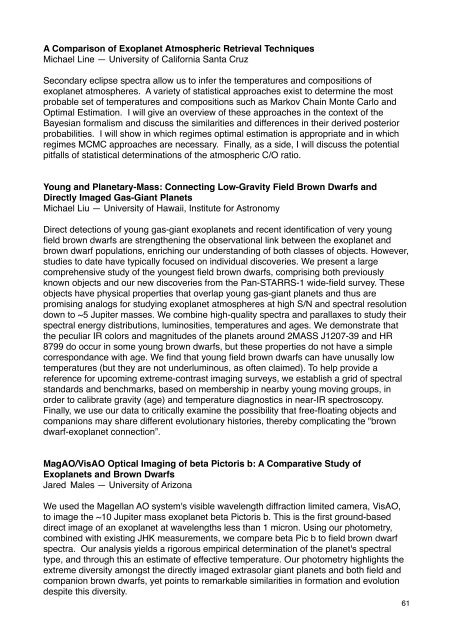Exoclimes_Conference_booklet1
Exoclimes_Conference_booklet1
Exoclimes_Conference_booklet1
You also want an ePaper? Increase the reach of your titles
YUMPU automatically turns print PDFs into web optimized ePapers that Google loves.
A Comparison of Exoplanet Atmospheric Retrieval Techniques<br />
Michael Line!— University of California Santa Cruz<br />
Secondary eclipse spectra allow us to infer the temperatures and compositions of<br />
exoplanet atmospheres. A variety of statistical approaches exist to determine the most<br />
probable set of temperatures and compositions such as Markov Chain Monte Carlo and<br />
Optimal Estimation. I will give an overview of these approaches in the context of the<br />
Bayesian formalism and discuss the similarities and differences in their derived posterior<br />
probabilities. I will show in which regimes optimal estimation is appropriate and in which<br />
regimes MCMC approaches are necessary. Finally, as a side, I will discuss the potential<br />
pitfalls of statistical determinations of the atmospheric C/O ratio.<br />
Young and Planetary-Mass: Connecting Low-Gravity Field Brown Dwarfs and<br />
Directly Imaged Gas-Giant Planets!<br />
Michael Liu — University of Hawaii, Institute for Astronomy!<br />
Direct detections of young gas-giant exoplanets and recent identification of very young<br />
field brown dwarfs are strengthening the observational link between the exoplanet and<br />
brown dwarf populations, enriching our understanding of both classes of objects. However,<br />
studies to date have typically focused on individual discoveries. We present a large<br />
comprehensive study of the youngest field brown dwarfs, comprising both previously<br />
known objects and our new discoveries from the Pan-STARRS-1 wide-field survey. These<br />
objects have physical properties that overlap young gas-giant planets and thus are<br />
promising analogs for studying exoplanet atmospheres at high S/N and spectral resolution<br />
down to ~5 Jupiter masses. We combine high-quality spectra and parallaxes to study their<br />
spectral energy distributions, luminosities, temperatures and ages. We demonstrate that<br />
the peculiar IR colors and magnitudes of the planets around 2MASS J1207-39 and HR<br />
8799 do occur in some young brown dwarfs, but these properties do not have a simple<br />
correspondance with age. We find that young field brown dwarfs can have unusally low<br />
temperatures (but they are not underluminous, as often claimed). To help provide a<br />
reference for upcoming extreme-contrast imaging surveys, we establish a grid of spectral<br />
standards and benchmarks, based on membership in nearby young moving groups, in<br />
order to calibrate gravity (age) and temperature diagnostics in near-IR spectroscopy.<br />
Finally, we use our data to critically examine the possibility that free-floating objects and<br />
companions may share different evolutionary histories, thereby complicating the "brown<br />
dwarf-exoplanet connection”.<br />
MagAO/VisAO Optical Imaging of beta Pictoris b: A Comparative Study of<br />
Exoplanets and Brown Dwarfs!<br />
Jared! Males — University of Arizona<br />
We used the Magellan AO system's visible wavelength diffraction limited camera, VisAO,<br />
to image the ~10 Jupiter mass exoplanet beta Pictoris b. This is the first ground-based<br />
direct image of an exoplanet at wavelengths less than 1 micron. Using our photometry,<br />
combined with existing JHK measurements, we compare beta Pic b to field brown dwarf<br />
spectra. Our analysis yields a rigorous empirical determination of the planet's spectral<br />
type, and through this an estimate of effective temperature. Our photometry highlights the<br />
extreme diversity amongst the directly imaged extrasolar giant planets and both field and<br />
companion brown dwarfs, yet points to remarkable similarities in formation and evolution<br />
despite this diversity.<br />
61


